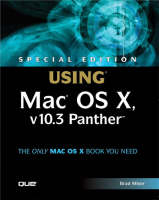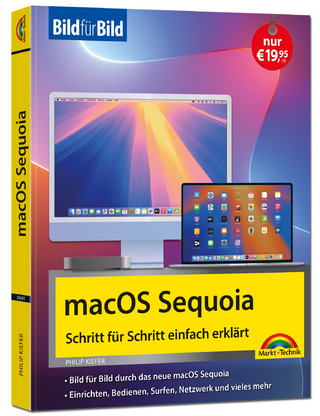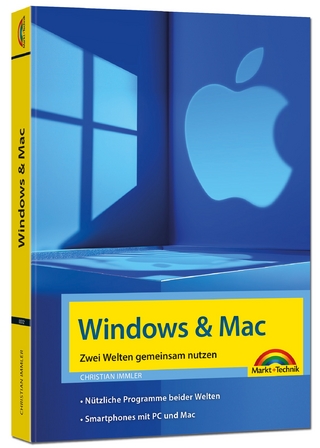
Special Edition Using Mac OS X v10.3 Panther
Que Corporation,U.S. (Verlag)
978-0-7897-3075-6 (ISBN)
- Titel ist leider vergriffen;
keine Neuauflage - Artikel merken
The Panther release of Mac OS X continues the development of the Macintosh operating system. Mac OS X has become the dominant OS on the Macintosh platform and is currently the default OS on all new Macintosh computers. Mac OS X is a complex and powerful operating system for which no documentation is provided by Apple outside of the Apple Help system, which contains very limited information.
Special Edition Using Mac OS X Panther provides the in-depth, wide ranging coverage that enables Mac users to get the most out of the operating system and included tools.
This book explains how to get the most out of the core OS, including the Finder, desktop, and system customization. The book also shows readers how to use OS X's Internet applications for email, Web surfing, and .mac for publishing content on the Net.
One of the book's major strengths is the extensive coverage of iTunes, iPhoto, iDVD, and iMovie. QuickTime and QuickTime Pro are also covered. The book helps readers understand and configure the technologies to expand their systems.
Brad Miser has written extensively about all things Macintosh, with his favorite topics being OS X and the amazing "i" applications that empower Mac OS X users to unleash their digital creativity. In addition to Special Edition Using Mac OS X Panther, Brad has written many other books, including Mac OS X and iLife: Using iTunes, iPhoto, iMovie, and iDVD; iDVD 3 Fast & Easy; Special Edition Using Mac OS X v10.2, Mac OS X and the Digital Lifestyle; Special Edition Using Mac OS X; The iMac Way; The Complete Idiot's Guide to iMovie 2; The Complete Idiot's Guide to the iMac; and Using Mac OS 8.5. He has also been an author, development editor, or technical editor on more than 50 other titles. He has been a featured speaker on various Macintosh-related topics at Macworld Expo, at user group meetings, and in other venues. Brad is the senior technical communicator for an Indianapolis-based software development company. Brad is responsible for all product documentation, training materials, online help, and other communication materials. He also manages the customer support operations for the company and provides training and account management services to its customers. Previously, he was the lead engineering proposal specialist for an aircraft engine manufacturer, a development editor for a computer book publisher, and a civilian aviation test officer/engineer for the U.S. Army. Brad holds a Bachelor of Science degree in mechanical engineering from California Polytechnic State University at San Luis Obispo (1986) and has received advanced education in maintainability engineering, business, and other topics. In addition to his passion for Macintosh computers, Brad likes to run and play racquetball; playing with home theater technology is also a favorite pastime. He has also been a volunteer with the Zionsville Eagles High School football team. Once a native of California, Brad now lives in Brownsburg, Indiana with his wife Amy; their three daughters, Jill, Emily, and Grace; and their guinea pig, Buddy. Brad would love to hear about your experiences with this book (the good, the bad, and the ugly). You can write to him at bradmacosx@mac.com.
Introduction.
I. MAC OS X: EXPLORING THE CORE.
1. Mac OS X: Foundations.
Mac OS X: The Future Is Now. Mac OS X Benefits. Mac OS X Architecture and Terminology. Mac OS X Costs: Hardware Requirements.
2. Getting Started with Mac OS X.
Welcome to Mac OS X. Starting Up Mac OS X. Creating User Accounts. Logging In, Logging Out, Restarting, and Shutting Down Mac OS X. Configuring the Login Process. Testing and Configuring User Accounts. Troubleshooting.
3. Viewing and Navigating Mac OS X Finder Windows.
The Mac OS X Finder. Working with Finder Windows. Navigating Finder Windows. Customizing Finder Windows. Working with the Finder Window's Action Pop-Up Menu. Working with Labels. Mac OS X to the Max: Finder Window Keyboard Shortcuts.
4. Working on the Mac OS X Desktop.
The Mac OS X Desktop. Working with Mac OS X Menus. Working with the System Preferences Application. Managing Open Windows with Exposé. Understanding Mac OS X Directories. Working with Files and Folders. Getting Information on Items. Finding Files and Folders on Your Mac. Customizing the Mac OS X Desktop. Mac OS X to the Max: Desktop Keyboard Shortcuts.
5. Using and Customizing the Dock.
Understanding the Dock. Using Items on the Dock. Organizing the Dock. Customizing the Appearance and Behavior of the Dock. Working with Docklings. Mac OS X to the Max: Using Dock Keyboard Shortcuts.
6. Installing and Using Mac OS X Applications.
Understanding Applications You Can Run Under Mac OS X. Installing Mac OS X Applications. Launching Mac OS X Applications. Understanding and Using Standard Mac OS X Application Menus. Opening Documents in Mac OS X. Saving Documents in Mac OS X. Troubleshooting.
7. Working with Mac OS 9, the Classic Environment, and Classic Applications.
Understanding Mac OS 9.2, the Classic Environment, and Classic Applications. Installing, Configuring, and Running the Classic Environment. Installing and Using Classic Applications. Running Mac OS 9.2. Troubleshooting.
8. Configuring, Customizing, and Exploring Mac OS X.
Setting Your Preferences. Using the Color Picker to Choose Colors. Controlling Open Applications. Using Disks and Discs. Working with Your iDisk. Controlling System Startup. Installing and Using Mac OS X Fonts. Logging In As Root. Mac OS X to the Max: Exploring Mac OS X.
9. Unix: Working with the Command Line.
A Command Line with the Mac OS? Learning Unix by Example. Working with Basic Unix Applications. Mac OS X to the Max: Unix Resources.
II. MAC OS X: CONNECTING TO THE WORLD.
10. Connecting Your Mac to the Internet.
Connecting to the Internet. Choosing Your Internet Connection Technology. Obtaining and Configuring an Account. Configuring Your Mac for Internet Access. Troubleshooting.
11. Using an AirPort Network to Connect to the Internet.
AirPort Wireless Networking. Setting Up an AirPort Base Station. Connecting to the AirPort Network with Mac OS X. Troubleshooting. Mac OS X to the Max: Making the Most of AirPort.
12. Using Email.
Introducing the Address Book and Mail. Setting Up and Using an Address Book. Configuring Mail. Sending, Receiving, and Replying to Email. Customizing Your Email. Sending and Receiving Files with Email. Searching Email. Troubleshooting. Max OS X to the Max: Email Away.
13. Surfing the Web.
Browsing the Web with Safari. Using Sherlock to Search the Web. Downloading and Preparing Files. Working with Plug-Ins and Helper Applications. Mac OS X to the Max: Going Further on the Web.
14. Putting Yourself on the Web.
Developing Your Presence on the Web. Using a .Mac iDisk and HomePage to Create and Serve Your Web Pages. Using Mac OS X to Serve Web Pages. Troubleshooting.
III. MAC OS X: LIVING THE DIGITAL LIFE.
15. Creating and Editing Digital Images.
Capturing Images for the Digital Lifestyle. Capturing Images Using a Digital Camera. Downloading Images to Your Mac. Sharing Imaging Devices on a Network or Via the Web. Capturing Screen Images. Using iPhoto to Master Digital Images. Working with Preview. Troubleshooting. Mac OS X to the Max: Going All Out with iPhoto Keyboard Shortcuts.
16. Listening to and Working with Music.
Understanding Music on the Mac. Exploring iTunes. Listening to Audio CDs with iTunes. Adding Music from Audio CDs and the Internet to Your iTunes Music Library. Adding Music from the Apple Music Store to Your iTunes Music Library. Organizing Your Music with the iTunes Library, Standard Playlists, and Smart Playlists. Customizing Music Playback. Making Your Music Mobile. Sharing iTunes Music on a Network. Troubleshooting. Mac OS X to the Max: More Music.
17. Making Digital Movie Magic with iMovie.
Working with Digital Video. Choosing and Using a DV Camcorder. Working with iMovie. Building a Basic Video Track. Adding Transitions. Adding Titles. Adding Special Effects. Using Sound in Your Movies. Distributing Your Movie. Troubleshooting. Mac OS X to the Max: iMovie Editing Shortcuts.
18. Watching and Creating DVD Movies.
Taking Advantage of DVD on the Mac. Watching DVD Movies on the Mac. Creating Your Own DVDs. Troubleshooting. Mac OS X to the Max: And DVD for All.
19. Viewing, Editing, and Creating QuickTime Movies.
Understanding QuickTime and QuickTime Pro. Upgrading and Configuring QuickTime. Viewing QuickTime Movies. Creating and Editing a Movie with QuickTime Pro. Creating a QuickTime Slideshow. Customizing Your QuickTime Movies. Troubleshooting. Mac OS X to the Max: Taking QuickTime Further.
20. Using the Other i Applications.
Working with iCal, iSync, and iChat. Managing Your Calendar with iCal. Synchronizing with iSync. Communicating with iChat AV.
IV. MAC OS X: EXPANDING YOUR SYSTEM.
21. Understanding Input and Output Technology.
Understanding Interface Technology. Working with External Interfaces. Using Internal Interfaces.
22. Working with Input Devices.
Choosing an Input Device. Finding, Installing, and Configuring a Keyboard. Finding, Installing, and Configuring a Mouse. Installing and Using an Ink Device. Finding, Installing, and Using Bluetooth Devices. Mac OS X to the Max: Inputting More Better and Faster.
23. Finding, Installing, and Using Output Devices.
Working with Output Devices. Finding, Installing, and Using a Monitor. Finding, Installing, and Using Speakers. Finding, Installing, and Using Printers. Working with Mac OS X's Built-in Fax Capability. Working with PDFs. Synchronizing Color Among Devices. Troubleshooting.
24. Understanding and Using Data Storage Devices.
Understanding Data Storage Options. Choosing, Installing, and Using a Hard Drive. Finding, Installing, and Using a CD Writer. Burning DVDs with Apple's SuperDrive. Burning CDs/DVDs with Disk Utility. Using a Tape Drive. Working with Other Removable Media Drives. Troubleshooting.
25. Installing and Configuring Connecting Devices.
Using Hubs to Connect Your Mac to Networks or Peripheral Devices. Finding and Installing an Ethernet Hub. Finding, Installing, and Using a USB Hub. Finding, Installing, and Using a FireWire Hub. Choosing a Modem.
V. MAC OS X: LIVING IN A NETWORKED WORLD.
26. Building and Using a Network.
Local Area Networking with Mac OS X. Designing a Network. Building a Network. Configuring the Services on a Network. Monitoring and Administering a Network. Troubleshooting. Mac OS X to the Max: Networking Mac OS X with Windows Computers.
27. Sharing an Internet Connection.
Enabling Multiple Macs to Use a Single Internet Account. Using AirPort to Share an Internet Account. Using a Mac Running OS X to Share an Internet Account. Using Multiple IP Addresses to Share an Internet Account. Using a Hardware DHCP Server to Share an Internet Account. Troubleshooting. Mac OS X to the Max: Troubleshooting a Network Connection.
VI. MAC OS X: PROTECTING, MAINTAINING, AND REPAIRING YOUR MAC.
28. Maintaining and Protecting Your Mac.
Keeping Your Mac Safe and in Good Working Condition. Maintaining Your Mac. Backing Up Your System. Securing Your Mac. Defending Your Mac from Net Attacks. Mac OS X to the Max: Going Further with Disk Utility.
29. Solving Mac Problems.
Handling Mac Problems. Understanding the Causes of Problems. Preventing Problems. Assessing Your Mac. Solving Problems. Mac OS X to the Max: Getting Help for Your Problem.
VII. MAC OS X: APPENDIXES.
Appendix A. Installing and Maintaining Mac OS X.
Moving to and Maintaining Mac OS X. Moving to Version 10.3 from Previous Versions of Mac OS X. Moving to Version 10.3 from Mac OS 9.x.x or Earlier. Updating Your Mac OS X Installation. Troubleshooting.
Appendix B. Computing on the Move with PowerBooks and iBooks.
Using Mac OS X on a Mobile Computer.
Index.
| Erscheint lt. Verlag | 22.1.2004 |
|---|---|
| Sprache | englisch |
| Maße | 230 x 189 mm |
| Gewicht | 1742 g |
| Themenwelt | Informatik ► Betriebssysteme / Server ► Macintosh / Mac OS X |
| ISBN-10 | 0-7897-3075-8 / 0789730758 |
| ISBN-13 | 978-0-7897-3075-6 / 9780789730756 |
| Zustand | Neuware |
| Informationen gemäß Produktsicherheitsverordnung (GPSR) | |
| Haben Sie eine Frage zum Produkt? |
aus dem Bereich


